How To Make A Window Frame
How to make shed window frames
Making shed window frames can sometimes be the merely option. Information technology may exist that yous demand to supplant some old garden shed window frames and can't find the right size or it may be that y'all are edifice a new shed and only fancy building your own window frames for a claiming.
Either way there are quite a number of details to understand and get right to make sure that you become the sort of performance that you desire. So, lets have a look at these details get-go and and then get into the stride by stride process of shed window frame construction.
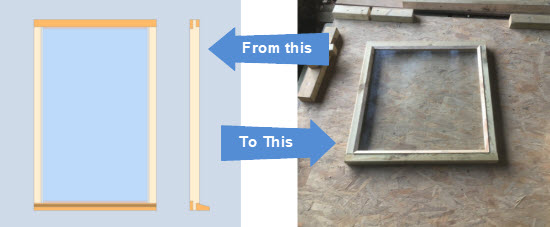 Shed window frames from concept to completion
Shed window frames from concept to completion
What are some of the details required to make shed window frames water and weatherproof
The first matter to address is that these are shed windows, not firm windows. They share many details mutual to all windows but shed windows don't demand to made to the aforementioned price/performance standards equally house windows.
House windows are quite a technological marvel, having a host of standards and design practices to ensure that indoor living spaces are dry, draught free and durable. A shed window doesn't demand to perform to the aforementioned level as a house window, merely they certainly do need to do an effective job of letting light into your shed whilst keeping the h2o out.
Making your own shed windows gives yous the opportunity to save coin whilst also gaining an appreciation of the details that go into window construction, likewise as the huge sense of satisfaction of making something that will work well for many years.
The details that we need to consider are:
- 1. What type of timber to use for the shed window frame
- 2. What size timbers to employ for the window frame
- 3. What type of joint to use to connect the shed window frame members
- iv. The options for glazing your shed window
1. What type of timber to utilize for the shed window frames
This depends on how long y'all would like your shed to last. The master enemy of any shed window is the combination of water and sunlight. Sunlight repeated heats and cools the timber which over the huge number of cycles in a twelvemonth causes the timber to split. Water volition discover its mode into any splits in the wood or gaps in joints and over the years will initiate decay.
And then, for whatsoever timber you lot choose if you tin provide protection to the timber with regular maintenance and awarding of a good quality pigment or stain so that will prolong its life.
Many shed windows are synthetic from redwood timber and 'dip treated' against decay. Combined with regular maintenance and detailing this approach tin can requite many years of service. In this project I use pressure treated (tantalised) structure timber. This isn't particularly fancy but gives a serviceable and durable window. If this was from a big window manufacturer and so all the components would be pressure treated/tantalised after fabrication and so that all the cut sections of timber were fully protected.
This isn't the case here, so if you lot are particularly concerned and your window is particularly exposed then treating all of the cutting surfaces with something such as SikaGard Forest Preserver and painting prior to assembly will give additional protection.
two. What size timbers to use for the shed window frame
For the shed window frames in this example I used 45x45mm (ii"x2") timber for the height and sides and a department of 95x45mm (4"x2") for the window cill. These members gave a good dimensional balance to provide the strength and stability for a single glazed window and too reasonable dimensions for fitting the glass and securing to the rough opening in the shed wall. Each of the sides and top member accept a 10x15mm groove machined in them to accommodate the drinking glass and glazing dewdrop.
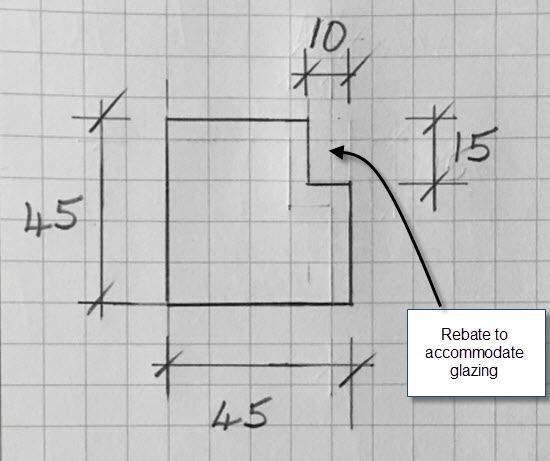 Typical section through timber for shed window frame
Typical section through timber for shed window frame
The window cill is a different section than the rest of the frame. By machining the bottom section of the window out of 4x2", the cill and the window frame are fabricated out of a single piece.
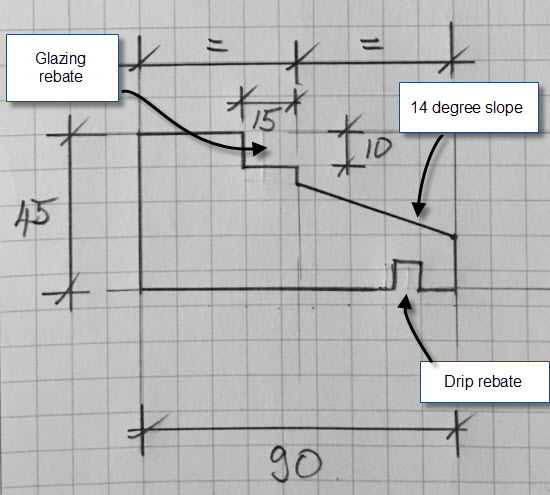 Section through shed window cill showing details
Section through shed window cill showing details
There are a couple of points to annotation here, the slope of the cill and the baste groove.
one. The window cill is cut with a 14 degree slope to help it effectively shed the rain.
2. The drip groove on the underside of the shed window cill is there to force the water running down the window and onto the cill to drop off onto the basis, rather than continuing to period underneath the cill and back into the shed.
Now I have introduced you to the various parts of the shed window frame permit'south take a look at how to make them, fit them together and install the shed window into the wall of your shed.
3. What type of articulation to use to connect the window frame members
The options for connecting your shed window frame members range from the simple butt joint to complex routered connections which require quite complex tooling. A quick overview of three types of shed window frame connectedness are:
The unproblematic butt joint.
This type of joint is very minimalist and would be frowned upon by many. Still, I take seen information technology used successfully on sheds that I have repaired so don't dismiss it out of hand immediately. The joint requires a small notch to be cut in the cease of the 2 horizontal timbers and the frame members are connected with screws as shown. Screwing into timber end grain isn't the strongest way of connecting so if you wanted some additional strength so using pocket screws would be a good improver.
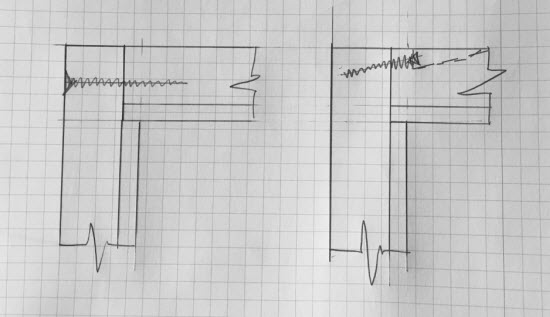 Particular of butt joint. Left hand side is with simple screw to secure frame members. Right mitt side is amend connection using pocket hole screw.
Particular of butt joint. Left hand side is with simple screw to secure frame members. Right mitt side is amend connection using pocket hole screw.
The 'bridle' articulation.
This joint is similar to a mortice and tenon joint merely with i cease of the mortice open up. The joint is held in place with glue and can be further strengthened with a wooden dowel or star dowel.
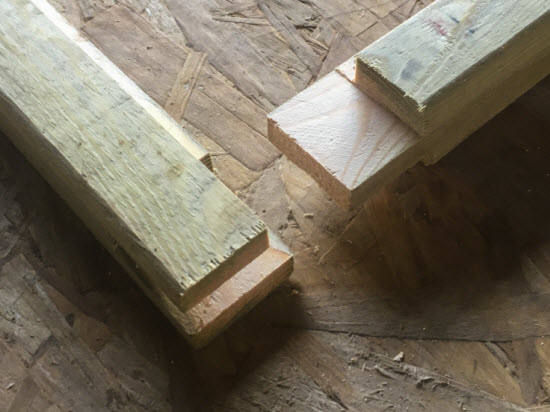 Detail of shed window frame articulation
Detail of shed window frame articulation
Automobile cut joint
A more sophisticated looking joint can be accomplished by using rail and stile router cutters this achieves a similar strength to the bridle joint. But of course teh ultimate window making machinery would be to utilize a spindle moulder, but so you lot are getting into the realms of house windows, which isn't what this article is most!
The butt joint and the determent joint can both exist cut with a hand saw or saw demote. The machine cutting joint is cut either on a router table or spindle moulder. So for this project I have shown the bridle joint which is stronger than the barrel joint.
4. The options for glazing your shed window
Traditionally, glass was held in in the window frame with metal glazing sprigs prior to applying putty around the perimeter of the window.
Many shed windows which are externally glazed don't use any sealant. The glass is just placed in position and a glazing quadrant held in place with 15mm long pins. If you desire a better seal, or more likely to stop the glass rattling in the pane, then run a dewdrop of silicone sealant around the perimeter of the glazing rebate before placing the glass. The seal betwixt the drinking glass and the frame will brand the joint water proof.
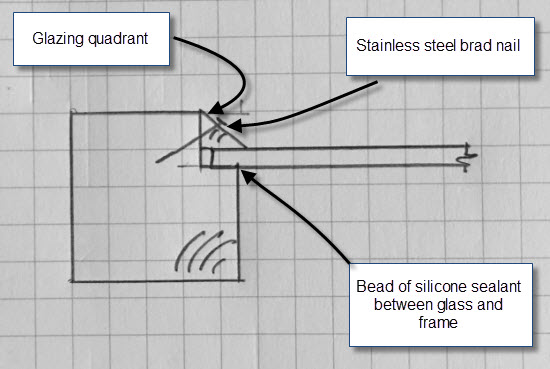 Section through window showing how glass is held in place
Section through window showing how glass is held in place
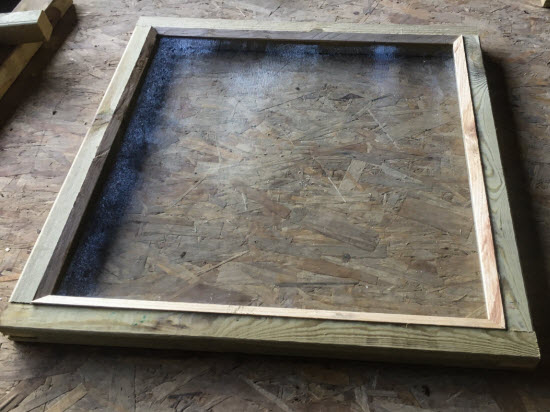 Completed shed window frame
Completed shed window frame
The very simplest method of holding the glass in place is to just create a slot on the inside confront of each member of the frame. This allows you to insert the glass as you assemble the frame. This is good in some ways for security as the glass cannot be removed without dismantling the frame. Even so, if the drinking glass gets cleaved there is no way of replacing the pane without removing then dismantling the shed window frame.
Well-nigh frames don't have this slot, but employ the rebate organisation. And the glass tin be easily replaced if it becomes broken.
How to brand a shed window frame step by step
The post-obit sequence is a shed window frame that I fabricated using the drawing beneath.
The window is a fixed, non-opening, window. It is made from pressure treated timber, three sides are 2x2" and the bottom is machined from 4x2".
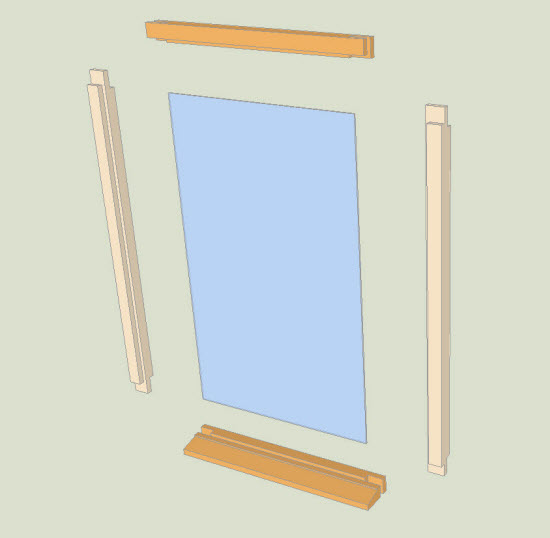 Components to be made for this project
Components to be made for this project
The members are joined using a bridle joint at the corners and glued together. The frame is then screwed into position to connect it to the shed frame.
The window is glazed with 4mm toughened drinking glass fitting into a 10x15mm rebate effectually the frame. The glass is sealed effectually the perimeter using a bead of silicone sealant and then fixed in identify with 10x12 timber glazing quadrant fixed with stainless steel brad nails.
So now that you know about the project let's go started:
The first pace is to cutting the members to length.
To calculate the length, let ii.5mm tolerance all circular the frame.
For this frame with a standard 610x610mm pane of horticultural glass the frame members were 30+two.5+610+2.five+30 = 665mm long.
As the window frame is to exist foursquare then each member is the same length.
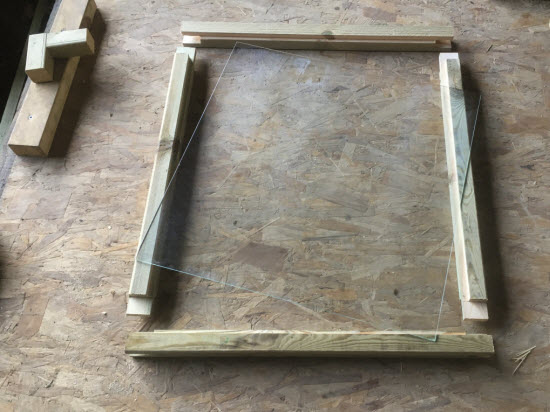 Members cut to length and with joints formed on the ends
Members cut to length and with joints formed on the ends
A rebate is cut in each fellow member of size 10x15mm to suit the glass and the glazing quadrant. This tin can be cut using a router in a router table or using a table saw.
The window cill section is cut using the blade of table saw set to a xiv caste angle. The drip groove is cutting to 10mm deep and with three passes of the saw to class a groove 7.5mm wide.
Now that you have the basic shed window frame stock, the next footstep is to cutting the joints.
Cutting the joints
No special equipment is required to cut the joints. It is perfectly possible to cut these uncomplicated joints with a hand saw and to apply a hammer and chisel to remove the waste where necessary. For this project I used a table saw and some jigs to speed up the cutting process.
As with any woodworking project of this type take great care to mark out the joints and understand which section of wood is to be removed before taking it out. Act in hast apologize at leisure!
In one case you lot take all the joints cutting, check that they fit
Dry fitting the frame
Try fitting the four members together to check that they fit. Measure across the diagonals of the frame to make sure that the frame is square (both diagonal measurements the same). Also check that the glass fits in the glazing rebate.
Gluing the parts together
When yous have ensured that all the parts fit together well it is fourth dimension to make the joints permanent. Before yous showtime to glue make sure you have some clamps to concord the pieces in place before the glue sets. I used some fairly standard bar clamps, but you could use some straps to utilize some pressure if you don't have these to hand.
I used some water proof polyurethane glue for the joints. Likewise every bit being waterproof this expands into the joints and fills any pocket-sized gaps.
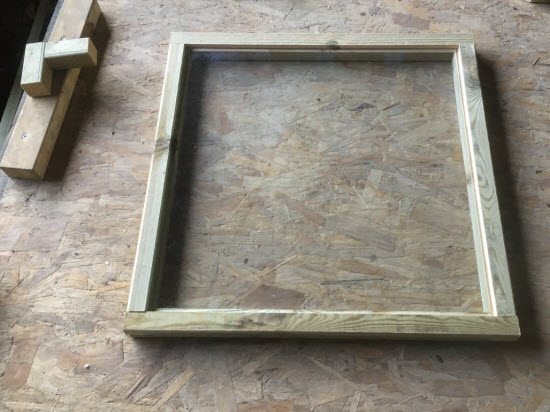 Window frame 'dry-assembled' with pane in place to check the fit
Window frame 'dry-assembled' with pane in place to check the fit
Glazing the window
The glass is all-time fitted after the frame is installed into the shed. This is considering if y'all are a bit rough with the installation information technology is quite easily possible to deform the frame and crack the glass.
A bead of silicone sealant is applied around the border of the rebate and the glass is then laid on to this. Another bead is so applied to the perimeter of the glass and the 10x10mm glazing quadrant fixed in place with stainless steel pins.
I cut my own glazing quadrant from a hardwood such equally oak or sweet chestnut, which is resistant to decay.
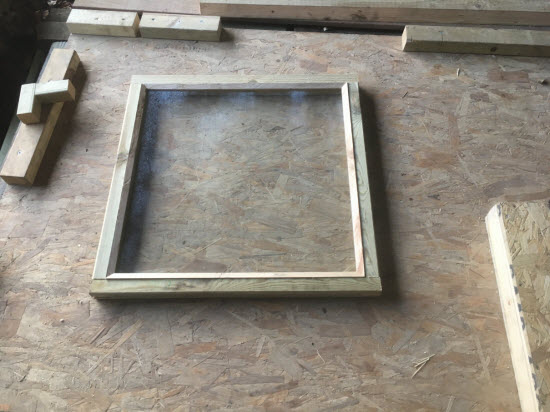 Completed window with glazing quadrant in place
Completed window with glazing quadrant in place
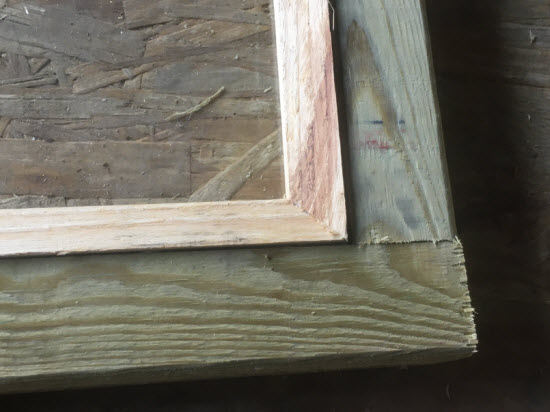 Close up item of glazing quadrant
Close up item of glazing quadrant
Conclusion
Of course, you lot don't have to be limited to a single paned window.
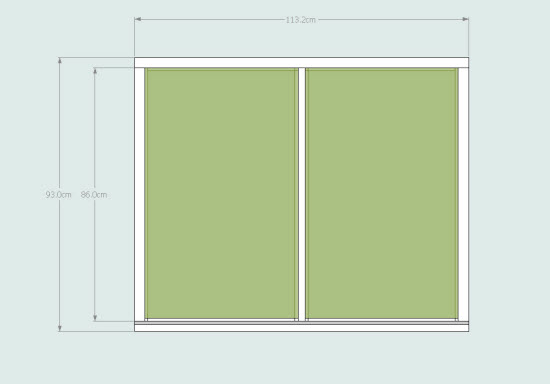 Window frame with two panes
Window frame with two panes
I hope you found this commodity useful for making fixed shed window frames.
If y'all would similar more than information allow me knowand I tin expand it to include opening, side or top hung shed window frames besides.
More information on the best blazon of shed window glazing can be found here.

Custom Search
Keep in touch on with our monthly newsletter
Shed Building Monthly
Source: https://www.secrets-of-shed-building.com/shed-window-frames.html
Posted by: williamsmannion.blogspot.com

0 Response to "How To Make A Window Frame"
Post a Comment